Essays and travelogues about Medieval France and Italy, focusing on the legends of Charlemagne as well as an occasional post on anything else that strikes my fancy.
Monday, July 28, 2008
Wine in a can? And I thought wine in a box was bad.
Then it went a step further and mentioned something I had heretofore been blissfully ignorant about.
Wine in a can.
Specifically champagne in a can.
:massages temples at the thought of such sacrilege:
Champagne is a wonderful thing. It is a wine used for celebrations and whose heritage dates back to the 17th century monk by the name of Dom Perignon who discovered the art of secondary fermentation and its wonderful byproduct of sparkling wine.
The second fermentation by tradition is done in the bottle, and is referred to as methode champenoise. The best sparkling wines are all done by this method and then there is another process to rid the bottle of the dead yeast that would otherwise be present as sediment in the bottle.
This old fashioned method involved turning the bottles in a rack a quarter turn or so each day as the angle of the bottles was slowly increased until the sediment settled in the neck of the bottle. The person who turned these bottles was given the title of "the Riddler."
No kidding. (Think about that this summer during the Batman media craze.)
Then they froze the neck of the bottles to make a solid plug of the dregs to remove it without spilling too much wine. After that extraction was completed, a cork was put in the bottle after refilling the bottle of spilled wine.
Today with the wonders of automation there isn't the need for hand riddlers, (and good thing too since I am sure they were prone to repetitive stress injuries).
With our modern technology there is also the ability for the secondary fermentation to be done not in the bottle, but in a stainless steel vat.
That is the method of choice for cheap sparkling wines such as Tott's or Ballatore.
Read your label. If it does not say "fermented in this bottle" or methode champenoise then it was probably created by methode champen-vat. Be especially suspicious if the price tag is less than $5 a bottle.
And now, thanks to film director-turned-winemaker Francis Ford Coppola who has purchased wineries in Sonoma County I now have in my vocabulary: methode champen-can.
Ugh.
I have not seen that in the stores, but then again, I have not been on the lookout for champagne in bright red cans.
It not only comes in a can, it comes with its own straw.
Pop open a flip top, then slurp sparking wine through a straw in a can. How utterly sophisticated.
That is not how you should imbibe champagne. This noble wine should be properly chilled and the sound of the cork popping helps set off your celebration. Then it is to be poured into fluted glasses to discern the size of the bubbles (they should be small and with a rapid stream and not like frogs eyes) and the shape of the glass also helps concentrate the wine properly on your tongue.
That is how it should be done.
I do not buy this excuse that wine in a box or wine in a can is more eco-friendly. I am sorry, but good wine needs to be treated with care.
If all you want is to have something to quaff with spaghetti on a Tuesday night and you do not want to spend a lot of money, go ahead and buy wine in a box. You certainly do not want to store it. Only buy wine in polystyrene if you are going to age the wine on the car seat on your way home.
Wine is a living, breathing entity that changes with time and with its surroundings. No two bottles of wine will ever taste exactly the same.
Wine reacts to fluctuations in temperatures, and it can age prematurely and/or "cook" the wine, sometimes ruining it.
The best example I know of this comes from my favorite wine columnist, Dan Berger. One of his columns was about how tanins in Cabernet Sauvignon can make the wine unapproachable when it is young and that it needs to age for several years before drinking. He then did an experiment and bought two bottles of Cab. One he treated properly by promptly placing it in his wine cellar, the other he left in the back of his station wagon and let it roll around for a week or so in the summertime.
Later he did a blind tasting with some of his friends who were not wine connoisseurs. They preferred the wine that had been abused over the one that was stored properly. Why? Because the abuse had tamed the tanins in the wine and made it drinkable younger than it ordinarily would have been.
I love that story and it reinforces why I am not that big of a Cabernet Sauvignon fan. I am not that patient to wait years to drink wine. Give me a glass of hearty Zinfandel any day over Cab. (And for those unfamiliar with Zin, I do not mean White Zinfandel which is a blush wine, I am talking about the hearty red wine that is a California heritage wine.)
Moving on to corks.
Corks can rot over time if bottles are stored upright. Therefore, watch out when you buy bottles of wine at your grocery store that are standing on a shelf for too long. If there's a layer of dust, you might want to pass on buying it.
To store wine properly in your home you do not have to have a special wine cellar or anything like that. All you need is an area where the temperature is constant and there isn't much commotion. Preferably without contact to an outside wall. We use the closet under our stairs to store our wine. Store the bottles on their side or in a case, but with the bottles upside down to keep the cork wet.
The Economist article also mentions a movement to get away from traditional cork and using of new synthetic corks as well as screw caps.
It depends on the wine whether or not you can really get away with that.
My favorite winemaker is Fred Scherrer and we have had several long conversations about the differences in these types of corks. He has experimented with them and found that for certain wines that do not age well, such as his Vin Gris or Dry Rosé that it is fine to use them. However, when a synthetic cork is used on bottles of wine that have a longer shelf life, it starts out fine but they do not age well. That is because the synthetic nature of the cork does not allow for the slow exchange of gases that is one of the functions of a traditional cork.
So he feels you can use synthetic corks for those types of wine which are thought of as the "chill it and kill it" wines, but not for wines that have any staying power.
By the way, I feel as if I should mention that I did not have any appreciation of wine when I grew up in the Midwest. Wine drinking around my family's table was usually Gallo jug wine with 7-Up.
Later after college, my girlfriends and I drank Bartles and Jaymes while the guys drank fizzy yellow beer.
My knowledge and appreciation of wine comes from touring and tasting at wineries, secondly from learning from friends who love wine, and thirdly from my own independent research that comes from supporting my local economy. We moved to Sonoma County in part so that we would be closer to the source of fine wine. That translates to better selection and lower prices since you do not have to pay for the long distance transport of wine.
Dan Berger once placed wine into three categories:
1) Wine he would buy.
2) Wine he would drink if someone else was buying.
3) Wine he would not drink even if someone else bought it.
Wine in a box is for me, category 3.
So is wine in a can.
Life is too short to drink bad wine.
Until next time,
Cheers!
Edited to add:
The Economist article appeared in the editorial page of my local paper this morning. Since we are in "the Wine Country" anything that has to do with the wine industry is fair game for news coverage in our paper that other papers might ignore. I shall be interested to see if there are any letters to the editor in response, especially from winemakers.
Wednesday, July 23, 2008
St. Antonin-Noble-Val from Celts to Romans to the movies

I have not given up on trying to catalog the various sites we visited last year in France on my research trip for my novel.
It is simply finding time to blog amongst all the other things that vie for my attention.
As I left off, my husband and I had spent a busy week in Paris visiting what seems like endless churches, museums and historical sites. Then we picked up our lease vehicle and drove south to the Midi-Pyrenees region after first stopping off to visit Guédelon. So we were in need of a rest and I had promised my husband that we would have a "down day" and not have to go fact finding.
That was my intention. Then we started chatting with our hosts Michael and Sarah about when farmers markets were held in the different towns and villages nearby.
So we set off to see Saint-Antonin on Sunday because of their market. We wound up going to this beautiful little village three separate times during our stay, because we enjoyed it so much. Twice for their market and once for information gathering from their tourist office.
The tourists to Saint-Antonin (or to the Midi-Pyrenees region in general) are mostly Brits and Dutch and most are there to simply soak up the beauty, but few ask the pointed questions I did about their history and legends. And seldom are there American tourists in this region, which I think is a shame because this area of France is wonderful.
Saint Antonin is situated at the confluence of the Aveyron and Bonnett Rivers and was called Condat during the Celtic period. Later, the Romans thought this was a "noble valley" and so the area was called Noble Val.
Then comes the legend of Saint Antonin which unfortunately is not listed in the online list of Catholic saints. There are many Saint Anthonys, but I once went through and checked each one and none had a story like this one that was given to me by the Tourist Office.
According to legend, the first evangelist arriving in Rouergue was St. Antonin. (sic) He was rapidly successful in his task and in spite of pleas of the inhabitants of Noble Val, he wanted to move on and carry the gospel on to Pamiers, his homeland. (sic)Due to my L.O.O.N.ish tendencies I must interject here that any missionary would not be called a saint during his or her lifetime, and the town of Pamiers was not named that at the time. Prior to the time of the Crusades, the town was Frédélas.
Antonin then went back to Frédélas in the hope of converting people to Christianity from whence he came. The people were not as receptive and he was beheaded and dismembered. Then comes the miracle, his remains were placed in a boat and two white eagles guided the boat which
"slid miraculously on the waters of the river and followed the Tarn and the Aveyron upstream. The boat stopped finally at the confluence of the Averyon and the Bonnett Rivers...
At that time, there was a rich and powerful count called Festus who ruled the 'Noble Val' of the Averyon valley. He recognised the hand of God in this wonderful voyage and laid the remains of the martyr in an impressive shrine where later an abbey was erected on the site."
The town credits the founding of the abbey to Pepin le Bref, better known as Charlemagne's father. Here is a picture of the historical marker which marks the spot of an abbey that was founded by a powerful Frankish king.
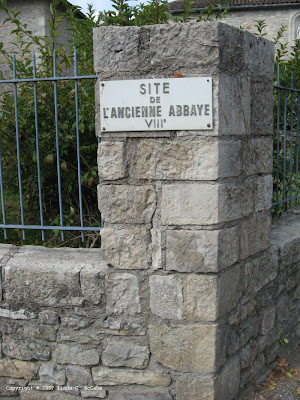
And this is what is left of that abbey.

Not much, eh? And no, it is not the steps, just the few pitiful stones left in a heap that the gardeners have to mow around.
One more historical marker just for good measure to show that at one time there was an abbey here that reportedly dates back to the time of Charlemagne which is the time period for my story.
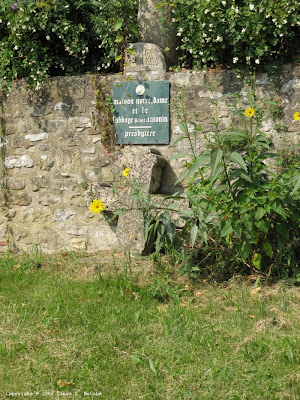
The town furthermore states that this was one of "three great Benedictine abbeys in the region of Rouerge with Conques and Vabres."
I had chosen to set the climax of my story in Saint Antonin because I needed a town in close proximity to other settings. I also needed to have an abbey. To find out that Saint Antonin not only had an abbey, but having it date back to Pepin le Bref was wonderful news to me. It validated my choice.
And since no one can tell me what the town looked like when the abbey was around, I am free to make it bend to my plot necessities.
The tourist office provided a map of the town and one feature to note was this stone engraving that is over someone's doorway that was supposed to have been taken from the crumbling abbey. Recycling if you will.

I believe it is supposed to be Jonah being swallowed by a whale.
The village had been named Saint Antonin for many centuries, but according to our guide it was in the 1950s that it was decided to add the words Noble Val to pay homage to its historical roots.
Thus the full name of this village is Saint-Antonin-Noble-Val.
According to the Michelin Green Guide the population is less than 2,000. However in comparison to the surrounding area, it seems like it is a big town and the farmers market was quite popular.
There were several streets that were filled with merchant stalls. Here is a picture of spices that unfortunately there is not the accompanying heady smell.

One vendor had about fifty different kinds of olives. Or perhaps it merely seemed that way, but alas we did not take a picture of his wide variety that seemed to stretch farther than many salad bars I have seen.
This picture is taken from the beginning of the market which stretched down the length of this street and spilled out onto another street.

There were fruits, vegetables, breads, meats, fish, sausages, clothes, leather goods, books, baskets, jewelry, and even kittens.
We had to stop when we saw kittens. I said the universal "awwwwe" when I picked up one of the kitties. The young woman then asked if I would like one.
I had to reply, "Je desolée. Je habite en Californie." Her eyes grew wide and then seemed to understand.
She did allow us to take a picture of her.
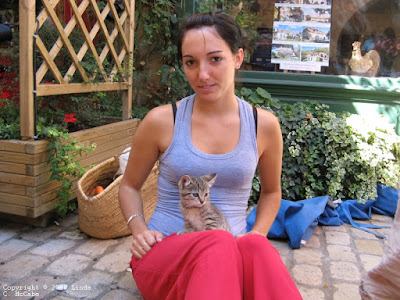
Here I am with the cute little one. I just love the little pink tongue hanging out. Of course he had just been drinking some milk right before I picked him up.
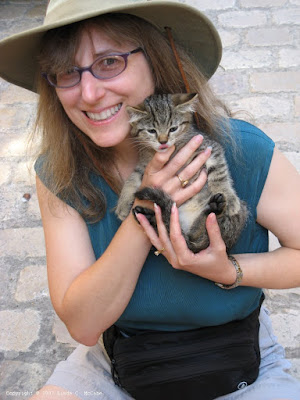 Then there were vendors who sold wine. You could buy a bottle of wine or bring your own and have it filled.
Then there were vendors who sold wine. You could buy a bottle of wine or bring your own and have it filled.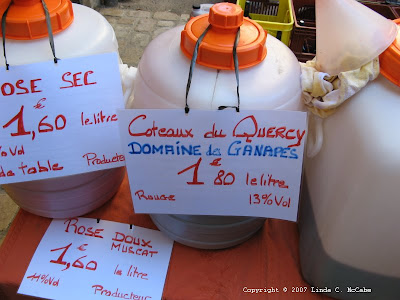
Then :shudders: they also had boxed wine.
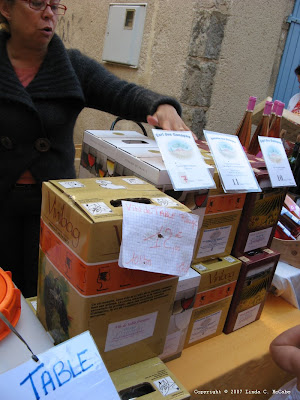 That is just. So. Wrong.
That is just. So. Wrong.I hate it that there is boxed wine available for sale in Sonoma County and/or the thought that some of the grapes grown here might be used to make wine stored in polystyrene. It just seems sacrilegious that there should be such things in France.
As for the town itself, it has a marvelous medieval charm about it. The buildings are old and stone, the streets are narrow.
 People live in the town itself and it is a bit scary when cars are traversing the narrow passageways. Here you can see what passes for a driveway before someone's home.
People live in the town itself and it is a bit scary when cars are traversing the narrow passageways. Here you can see what passes for a driveway before someone's home.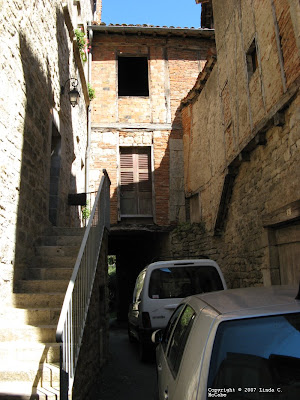
Here is a view of the center of the village on a non-market day.
 If it looks somewhat familiar, perhaps you have seen the movie Charlotte Gray which was filmed in Saint Antonin. It is a World War II film and the filmmakers had Nazi tanks coming down this very street with that hall in the background. I am amazed that they were able to maneuver tanks down that street.
If it looks somewhat familiar, perhaps you have seen the movie Charlotte Gray which was filmed in Saint Antonin. It is a World War II film and the filmmakers had Nazi tanks coming down this very street with that hall in the background. I am amazed that they were able to maneuver tanks down that street.Charlotte Gray is a good film, and whether or not you like the story or the acting, you cannot fault the beauty of the landscape that is shown.
On another post I will show you the Aveyron gorges. I just tried to upload those pictures, but got an error code from Blogger. I think I shall stop now before it eats another post of mine.
Wednesday, July 9, 2008
Guédelon, constructing a 13th century castle in 21st century France
About an hour and a half south of
Finding Guédelon is not altogether easy because it is off the beaten path, although there are many iconic signs posted along the roads with arrows to help reassure travelers that they are nearing their destination.
I first heard of Guédelon via a blog post written by an American blogger married to a Frenchman and lives in
As I paid for our admission tickets, a woman asked if my husband and I would like a guided tour. I did my best to respond in the affirmative if it was in English. She then surprised me when she switched immediately to English and asked where I was from. I had her repeat the question and then stumbled as I said, “
At that point, I felt as if the sky opened and sunshine rained down on me. Julie left the admissions window for a few minutes to answer some questions and gave us an overview of the site, but she did not have the time to do a full tour. (There was another window for admission tickets that was open, so she was not abandoning her post.)
Julie was enthusiastic about the project as well as the history of castles as she had learned from being a part of this experimental archaeology. Between her discussion, the book Guédelon: Fanatics for a fortress and the
Guédelon is the brainchild of Michel Guyot who had restored castles, but had always dreamed of building one. The epiphany came to him one night over drinks with friends at his restored castle in Saint Fargeau. By morning he realized that it would be a works program that would employ people in the process and that admission tickets from the public would cover the costs of construction.
He quickly found a partner in Maryline Martin.
She is the project manager and whose energy and drive became an unstoppable force of nature which led to the first subsidy grant ever by the Canal+ Foundation. Their CEO, Pierre Lescure, is quoted as saying about Martin and Guyot, “They’re mad! They’re really mad.” [i]
Madness is another word for passion and that is what started and sustains Guédelon. The estimated length of construction for this project is twenty-five years and they are now in their eleventh year.
Strategic lines of sight for defensive purposes while an important consideration during the Middle Ages was not what determined their choice of sites to build. Nor was proximity to a major city or mass transportation a factor, because it is in a rural area where you can only get there by car or possibly chartered bus. Instead, they focused on finding land which would have all the necessary natural resources. The construction site near Treigny is designed to be self-sufficient and everything that they use is crafted there: stone, sand, lime, clay, a forest, and the stone is ferruginous so it provides the iron necessary to produce the tools.
Inspiration for the architectural designs for the site came from thirteenth century castles built during the reign of Philippe Auguste and the plans were drafted by Jacques Moulin, architect-in-chief of Historic Monuments.
Here is a scale model of what the castle will look like upon completion:
Florian Renucci started out as a stone cutter, but within two years he became Guédelon’s site manager and is involved in every aspect of construction. On the DVD, he refers to this project as cultural heritage embodied by stone.
Speaking of stone, here are stone cutters at work:
They select rock from the quarry and split the stones by focusing their hammers on the different colored grains in the stone which denote weak points. Watching their back breaking labor makes me truly appreciate how difficult all the stone buildings were to make prior to the invention of power tools.
It also reinforced the idea that I heard repeatedly in
In
Here is a handcart that was crafted by the carpenters to transport some of the rock that was hewn by the stone cutters.
Large loads are placed in a cart and pulled by one of Guédelon’s two workhorses.
The rough hewn stones are brought to the stone masons who chisel the stone to fit the dimensions necessary. Certain specialized stones are carved for barrel arches, windows and doorways, while other stones are simply needed for the walls.
Here you can see the stone mason’s cottage where there are various forms hung above his head. On the left foreground you can see stone steps that will be a part of a circular staircase as well as stones that will be part of an archway. I thought it was interesting to notice that the flooring of the cottage needed repair, but it appears that the carpenters are too busy creating scaffolds than replacing floorboards.
Another marvel that was created by the stone cutters and stone masons was a single capstone used for the well. It is one large piece of stone and it will never be subjected to weakness or stress that is inherent with stones held together with mortar.
The finished stones are given marks by the stone masons and then transported to the work site itself and are laid in their proper place by the masons.
To lift the heavy loads up at the top of the construction site they use an old “human hamster wheel” whose design dates back to the time of the Romans.
The tools used are crafted by blacksmiths who repair several sets of tools from stone cutters and stone masons on a daily basis. It is said on the worksite that without the blacksmith there would be no tools.
The lead blacksmith is Thierry Darques who came to the job trained as a journalist. He jokes about the abrupt change in careers, but loves working with his hands. He was one of the first to join the project and apprenticed with master blacksmith Olivier Loiseau. He studies old manuscripts to see images of tools from the age and tries his best to copy them using the tools in his forge.[ii] The blacksmiths also forge the nails used in construction.
This bridge is made of wood from 57 oak trees and 670 hand forged nails.[iii]
They also do not use modern measuring equipment at the site. Instead they use the three tools found in a 13th century book: a stick, their feet and a cord.
In the video Alain Louis demonstrates the six measurements on a stick. The first measure is of four fingers grasping the stick (without the thumb) and is known as the hand’s breadth. The second measure was of the fingers being extended (still without the thumb). The third measure was the span spread that included the thumb. The fourth measure is the length of his foot. The fifth measure was the “L” or the distance between the tips of your fingers to the end of your elbow, also known as a cubit. The sixth measure was the diameter of the stick should be the size of the width of your thumb.
He also did a nifty demonstration with the cord having thirteen regularly placed knots in it. As he shifted the cord around it, he showed the school children rudimentary mathematics.
The work site has other trained artisans including:
● wood cutters who fell the trees in the forest
● carpenters who fashion the wood for wagons, scaffolds, and create wood shingles
● the rope maker who takes raw hemp grown in the forest and processes the fiber into rope
● basket weavers who take willow and wicker to create baskets that carry small rocks as well as mortar
● the mortar makers
● the tile maker who takes clay and soaks it in water to remove all the trapped air, shapes it into either roof or floor tiles, (sometimes adding dye to color the tile), drying it and then firing it in a kiln
● the dye maker
Here is one of the diagrams used in the planning of the castle:
And here one of the completed vaulted ceilings:
Guédelon has several technical advisors who visit the site periodically to ensure that the methodology is being done in as authentic a manner as is possible, (especially when certain knowledge of techniques was never written down but passed down from master to apprentice and so it is a matter of supposition.)
One of the advisors is an art historian from
For example there is this quote:
Thanks to the Guédelon site, Nicolas Reveyron and his colleagues have been able to verify that manure is by far the best protection against rain and frost for the wall crests, and they finally have scientific certainty that the vertical black discontinuities found in cathedrals correspond to pauses in construction. To date, no written evidence existed to explain these construction details.[iv]
Here you can see the vertical lines in the walls, as well as moss. The previous vaulted ceiling also has readily visible lines. Later the castle will be plastered to properly seal the mortar as well as covering over the unsightly blemishes that came with construction over time.
Guédelon is now the biggest employer in the Yonne Department with fifty employees. The are also about sixty regular volunteers who help out whenever they can and an even larger number of occasional volunteers who spend a week or two of their summer holiday assisting in the construction.
The site opened to the public in 1998 and in its first year had 50,000 visitors. It now has upwards of a quarter million tourists each year and its receipts from admissions, concessions and merchandise allows it to be self-sustaining.
Julie told us that a month before our visit that Rick Steves and his camera crew had come to the site. I have not yet seen it on PBS, nor any mention of this on his website, but I predict once this episode is viewed by Americans who are planning on traveling to
Oh and here’s a picture of Julie and myself.
The old “build it and they will come” mantra has proven to be correct. In fact, Guyot felt that seeing the construction of a castle would be more exciting for tourism than visiting a castle which had already been built.
Americans who are reading this post might be thinking something along the lines of “Why doesn’t someone do that here? We have all kinds of Renaissance Faires and chapters of the Society for Creative Anachronism. Surely there would be support for a castle building project in the
In fact, there is a group who wants to do just that and it has been the subject of posts by medievalist bloggers such as Heroic Dreams, Richard Scott Nokes, and Matthew Gabriele. Medieval
I spoke recently by phone to Roger Gomez and during our discussion I urged him to visit Guédelon and learn from their triumphs as well as their mistakes.
He then told me of their own board of advisors having the expertise of a professor of Medieval Literature from
Roger told me that he has four different business plans depending on how they achieve their capital. His preference is to follow Guédelon’s lead and use medieval construction techniques to create their vision of a medieval world. However, if they get corporate sponsorship that requires on rapid construction to complete the site on 21st century timetables, he will still insist on the integrity of the site.
He wants visitors to not be able to tell where things have been constructed in a faux manner. He wanted the look and feel of authenticity for the time period. (But maybe not the smells.)
Roger referred to this as an assembled heritage landscape and compared it to living history sites such as Colonial Williamsburg in
I asked about getting financial support from the various Ren Faires that are held each year, but so far there has not been an organized effort on their behalf. He said that if one million people who love the Middle Ages donated just $20 then they would have the money they needed.
Think about that. Instead of squandering $20 on a cheesy souvenir T-shirt at the next Ren Faire you attend, you could help support the initial funding of an American version of Guédelon. All you have to do is donate here.
Or you could become mad like Maryline Martin and Michel Guyot, and make this project happen here by pouring your heart and soul into this dream as well.
Here are some links to articles about Guédelon that I came across as I was researching for this blog post.
You can also find montage videos of Guédelonon YouTube. Here is one that is nice.